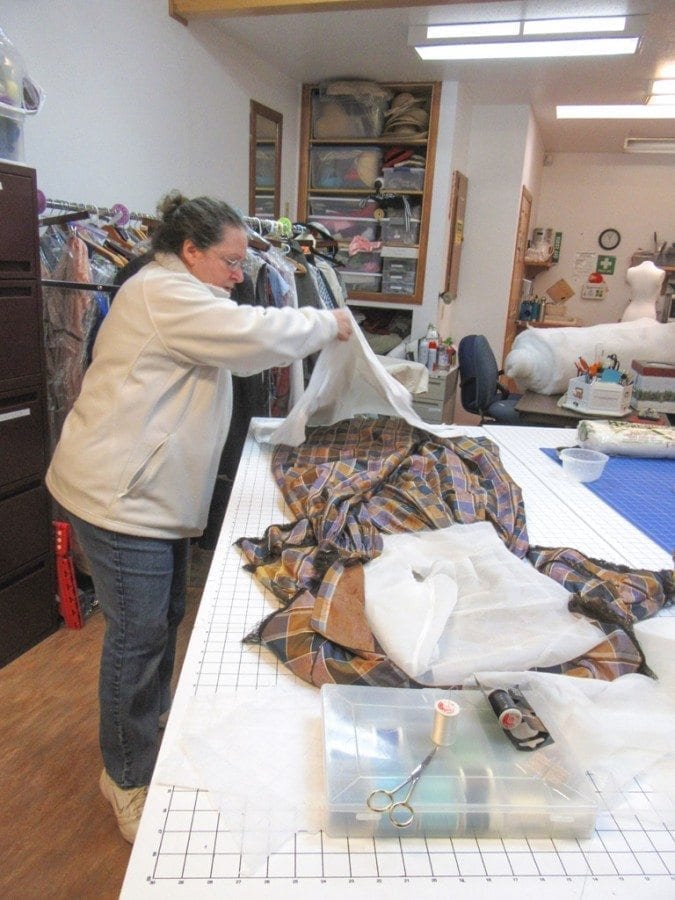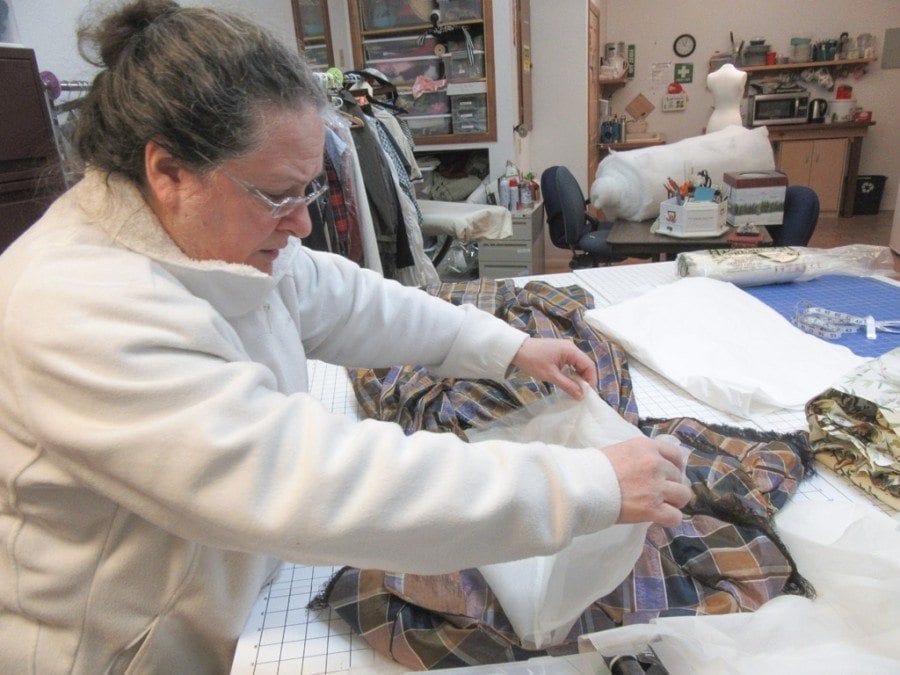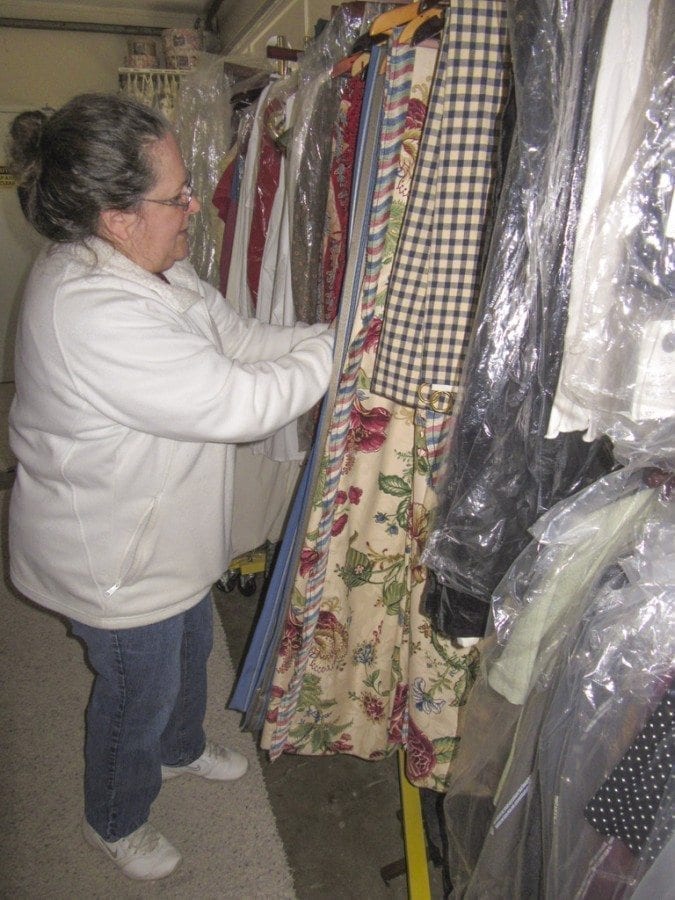
Carolyn Schultz-Rathbun
For ClarkCountyToday.com
VANCOUVER — Maria Pambrun, the French-speaking métisse daughter of a Hudson’s Bay Company fur trader, married Fort Vancouver physician Forbes Barclay in 1842, when she was 16. In 1850, the couple moved to Oregon City, where they would spend the rest of their lives. And that same year the 24-year-old Mrs. Barclay also acquired a silk plaid afternoon dress.

Fort Vancouver bought that dress at auction last year. And now Eileen Trestain, coordinator of the Period Clothing and Textiles Shop at the Fort, is conserving and mounting it, lining the entire dress with silk organdy to take the weight of the skirt off the fragile bodice, and building up a three-dimensional mount to custom fit the dress. When she is done, the dress will be displayed at the McLoughlin House in Oregon City.
Why not at the Fort?
Trestain says the Fort presents itself as it was in the 1840s, but the dress is from the 1850s. The Barclays lived in Oregon City by then, making McLoughlin House the appropriate place for its display.
Trestain, herself a volunteer, supervises 25 volunteers and over 9,000 pieces of clothing, representing the 1840s to the 1940s and worn by interpreters at Fort Vancouver and Vancouver Barracks.
“When I started there were about 500 pieces,” she says. “And I immediately eliminated about half of them. They were from the ‘70s and ‘80s. Information was not available then like it is now. The collection wasn’t as accurate as I wanted it to be. My aim has been to increase the historical accuracy. So we kept what we could.”

Some pieces — most military uniforms, for example — the Fort buys. Most — including virtually all women’s clothing — is made by volunteers. One of Trestain’s personal favorites is a white wool wedding dress.
“We’re trying to create the illusion of the past,” says Trestain. “We want people to feel like the interpreters have stepped out of the past. And it’s the small details that make the difference.”
So volunteers hand stitch buttonholes, and all visible seams.
The collection also contains some original pieces, many too fragile to wear, but kept for copying.
“We have some from the 1930s and ‘40s,’’ Trestain said. “We do wear those. We have a couple of pieces from 1910, but we don’t usually wear those. And anything before that is just too fragile. World War I and on, we might.”
Trestain, a textile historian who has authored two books on dating fabrics, has spent her whole life learning her craft.
“My mother was a professional seamstress, so I grew up with it in the home,’’ Trestain said. “Eventually she became the foreman in a baby clothes factory. And she gave lessons, teaching people to sew.”
And then there was Trestain’s grandmother.
“She was an amazing lady,’’ Trestain said. “She did all kinds of handwork. Made cinnamon rolls. Quilted. Made rag rugs. Knit. She was a prolific reader. She didn’t really sleep — kind of like me.”

Trestain grew up quilting with her grandmother, and learned to read history in a quilt.
“A lot of my grandmother’s quilts were made from our old clothes,’’ she said. “So you could point to a piece of fabric and say, ‘That was Aunt Carol’s (blouse). This was the baby’s dress.’”
Trestain became a certified appraiser of quilted textiles, and writes, speaks, and teaches on antique quilts and fabrics. She spent two years as collections manager at the Clark County Historical Museum before coming to the Fort in 2003.
Trestain also trains youth interpreters in the Fort’s two Living History Schools. Dame School students learn traditional feminine handwork skills, while those in the Young Engagé School learn carpentry, kitchen, and fur trading skills. Second-year students learn scrimshaw, whittling, apothecary, and etiquette. Third-year students and beyond add additional skills, including historical dance, and write the scripts for the winter Lantern Tours.
“We try to teach them to be good interpreters,” says Trestain. “We try all these different topics to hit on something that really interests them. And a lot of them stay (as interpreters at the Fort) for a long time.”

The goal, says Trestain, is to teach youth interpreters — and all of us — what it was like.
“Not to tell them it was all right, or wrong,’’ Trestain said. “But if they understand the past they will understand today. And if we completely ignore the past, we’ll make the same mistakes over again. There’s a lot of passing over, and not understanding what the past was.”
And so Trestain continues, one afternoon dress at a time.
“Doing this job uses all the skills I have in textiles,” says Trestain. “It puts them to good use. And it’s challenging. I never know what new thing there’s going to be today. It’s always changing. It’s not boring. There’s always something. And I really enjoy the people we work with.”
To make a donation, or to inquire about volunteer opportunities, contact the Fort Vancouver Costume Department at (360) 816-6259.
To learn more about, or to volunteer for, the Dame School or Young Engagé School (open to youth ages 10-18), go to https://www.nps.gov/fova/learn/kidsyouth/youth-volunteer-programs.htm.




